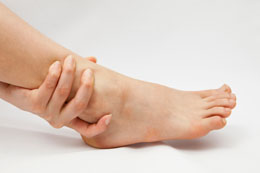Swollen ankles and feet are a common problem for those who travel long hours by air or by road. This is caused due to accumulation of fluids in the cells of the legs. Injury or sprains can also lead to swelling in the feet. This article provides information regarding the same.

Swollen ankles or feet can be caused due to accumulation of fluids in them. This condition is known as
edema. Edema occurs when fluid is retained in the inter-cellular spaces in the body. Though this condition occurs most commonly in the legs, ankles, and feet, edema can cause swelling of the entire body. Swelling of the ankles and feet can be caused due to certain medicines, health conditions, or trauma to these regions.
Causes
- Salt retention
- Insect bites
- Long airplane flights or rides in automobiles
- Eating food of low-nutrition value and high-sodium content
- Sitting or standing in the same position for a long time
- Injury or trauma like a sprain or fracture in the ankle or feet
- Varicose veins and history of phlebitis
Arthritis and gout in the joints may cause swelling in the ankle as well. Medical conditions like heart diseases, kidney failure, or liver failure can lead to the buildup of excess fluid in the body, especially in the legs and feet. Obstruction of the venous system during obesity and pregnancy, blood clots that obstruct the flow of blood, taking medicines related to blood pressure treatment, birth control, depression, etc., may also lead to edema. Individuals undergoing hormone replacement therapy may also experience retention of excess amounts of fluid in the body.
Symptoms
A person who has been affected by edema will experience pitting. Pitting refers to an indention that is caused if the swollen area is pressed for a few seconds and then left. This indention does not subside immediately on release of the pressure. Swelling for a long time will lead to skin ulceration.
Treatment
The condition can be easily treated at home by following some simple practices. First of all try to avoid conditions that may lead to swollen feet and ankles. This is important for old people and those who are prone to having swelling in their legs. Steps like cutting down on salt intake in diets, avoiding standing or sitting in one position for long time, and losing extra weight can help reduce the incidents of swelling on feet and ankles. Besides these, the following steps can also be useful:
- Use a leg wedge while sleeping so that the legs are raised above the level of the body. If you can manage, try to keep them elevated even while sitting.
- Do leg exercises as they will prevent the accumulation of fluids in your legs by pumping them to the heart.
- Take a low-salt diet as this reduces the amount of salt in body, resulting in lesser water retention.
- Avoid wearing clothes that fit tightly around the hips and legs.
- Although diuretics may be helpful, avoid taking an overdose of these pills.
- Take regular walks as walking works the muscles of the legs. This prevents fluid accumulation around the feet and ankles.
- Most drug stores sell support stockings. These come in varying gradients depending upon the pressure required. According to the spread of edema, the length of these stockings may also vary. Wear these to reduce the swelling.
- Certain drugs can also cause swelling. Get your prescriptions checked by the physician for calcium channel blockers and certain non-steroidal anti-inflammatory drugs that lead to swelling.
If some serious health reasons are suspected behind the swellings, consult a physician immediately. Tests like urine analysis, ECG, blood tests, etc., can help detect serious health problems, if any, due to which the swelling must have occurred.
Disclaimer:
This Buzzle article is for informative purposes only, and should not be used as a replacement for expert medical advice.


 Swollen ankles or feet can be caused due to accumulation of fluids in them. This condition is known as edema. Edema occurs when fluid is retained in the inter-cellular spaces in the body. Though this condition occurs most commonly in the legs, ankles, and feet, edema can cause swelling of the entire body. Swelling of the ankles and feet can be caused due to certain medicines, health conditions, or trauma to these regions.
Swollen ankles or feet can be caused due to accumulation of fluids in them. This condition is known as edema. Edema occurs when fluid is retained in the inter-cellular spaces in the body. Though this condition occurs most commonly in the legs, ankles, and feet, edema can cause swelling of the entire body. Swelling of the ankles and feet can be caused due to certain medicines, health conditions, or trauma to these regions.